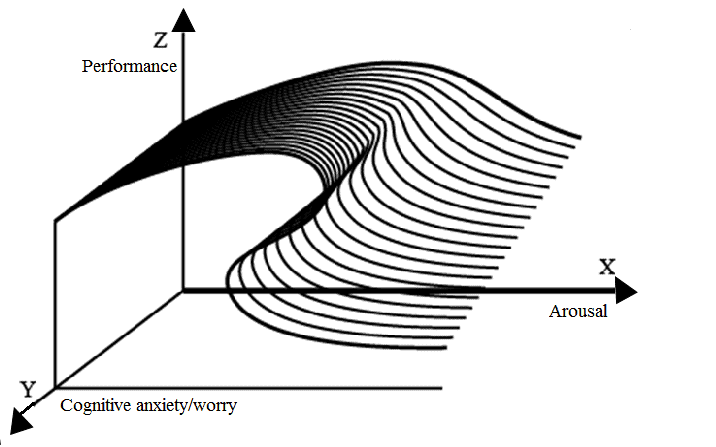Catastrophe Model of Anxiety
The Catastrophe Model of Anxiety proposes four specific relationships between cognitive anxiety, physiological arousal and performance (Hardy, 1990, 1996):
Cognitive anxiety (worry) has a positive linear relationship with performance when physiological arousal is low (see Figure);
2. Cognitive anxiety will have a negative relationship with performance when physiological arousal is high;
3. When cognitive anxiety is low, physiological arousal has an inverted U-shaped relationship with performance;
4. When cognitive anxiety is high, increased levels of physiological arousal lead to a catastrophic drop in athletic performance. Furthermore, once this catastrophic drop in performance has occurred, a large reduction in physiological arousal is required to bring performance back on to a higher level, again.
Thus, prior to the performance, an important mental task of athlete is to achieve a mental state where physiological arousal is at her optimal, rather moderate level, without worry thoughts. Usually, this means that physiological arousal is maintained by optimal warm-up and behavioral and mental precompetitive routines whereas worry thoughts are avoided by concentrating on personal challenge and excitement.
References:
Fazey, J. & Hardy, L. (1988). The Inverted-U Hypothesis: Catastrophe for sport psychology. British Association of Sports Sciences Monograph No. 1. Leeds: The National Coaching Foundation.
Hardy, L. (1990). A catastrophe model of anxiety and performance. In J. G. Jones & L. Hardy (Eds.), Stress and performance in sport. Chichester, UK: Wiley.
Hardy, L. (1996). Testing the predictions of the cusp catastrophe model of anxiety and performance. Sport Psychologist, 10, 140–156.
